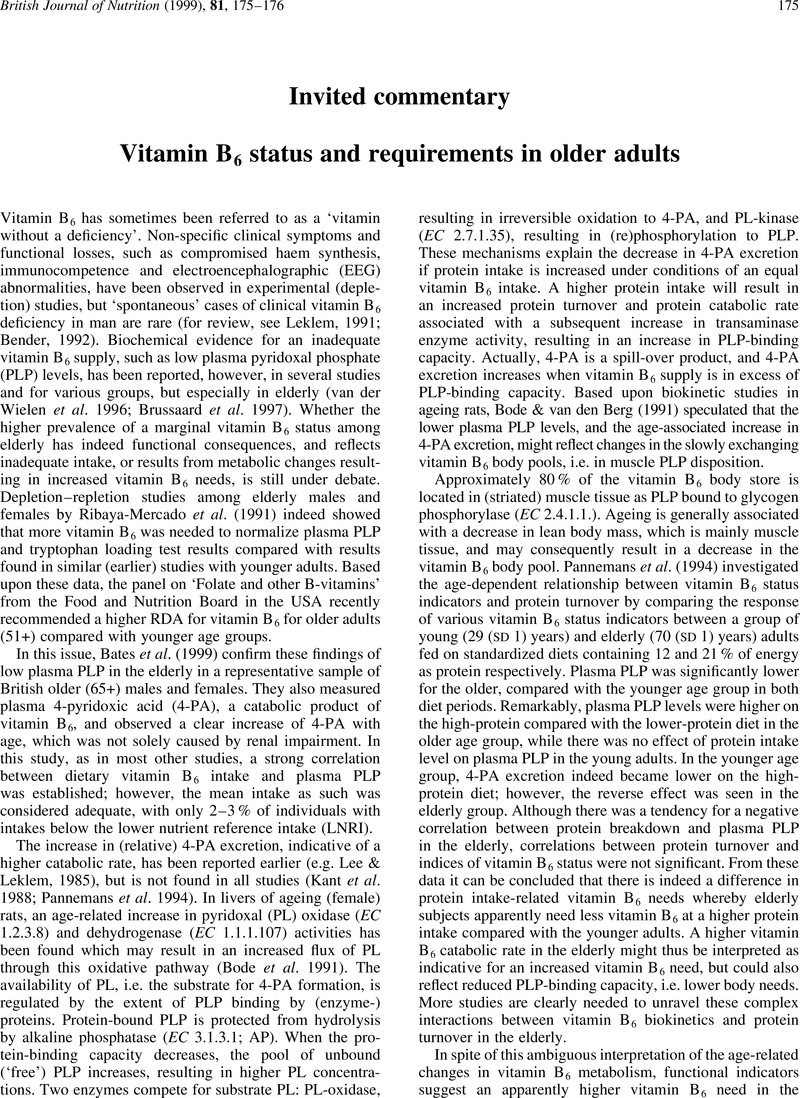Crossref Citations
This article has been cited by the following publications. This list is generated based on data provided by Crossref.
Bates, Christopher J
Pentieva, Kristina D
and
Prentice, Ann
1999.
An appraisal of vitamin B6status indices and associated confounders, in young people aged 4–18 years and in people aged 65 years and over, in two national British surveys.
Public Health Nutrition,
Vol. 2,
Issue. 4,
p.
529.
Wolters, Maike
Hermann, Silke
and
Hahn, Andreas
2003.
B vitamin status and concentrations of homocysteine and methylmalonic acid in elderly German women.
The American Journal of Clinical Nutrition,
Vol. 78,
Issue. 4,
p.
765.
Brachet, Patrick
Chanson, Aurélie
Demigné, Christian
Batifoulier, Frédérique
Alexandre-Gouabau, Marie-Cécile
Tyssandier, Viviane
and
Rock, Edmond
2004.
Age-associated B vitamin deficiency as a determinant of chronic diseases.
Nutrition Research Reviews,
Vol. 17,
Issue. 1,
p.
55.
Laufs, U.
Herrmann, W.
Strehlow, K.
Nickenig, G.
Kindermann, M.
Böhm, M.
Scheller, B.
Nickl, W.
Müller, P.
Seeland, U.
Jung, J.
Fries, R.
Waßmann, S.
Scheffler, P.
Wilkens, H.
Wendler, O.
Schäfers, H.-J.
Baumhäkel, M.
Cremers, B.
Link, A.
and
Hammer, B.
2004.
Männersprechstunde.
p.
81.
Paulionis, Lina
Kane, Sheri-Lynn
and
Meckling, Kelly A
2005.
Vitamin status and cognitive function in a long-term care population.
BMC Geriatrics,
Vol. 5,
Issue. 1,
Porter, Kirsty
Hoey, Leane
Hughes, Catherine
Ward, Mary
and
McNulty, Helene
2016.
Causes, Consequences and Public Health Implications of Low B-Vitamin Status in Ageing.
Nutrients,
Vol. 8,
Issue. 11,
p.
725.
Sharma, Pankaja
Han, Soo Min
Gillies, Nicola
Thorstensen, Eric B.
Goy, Michael
Barnett, Matthew P. G.
Roy, Nicole C.
Cameron-Smith, David
and
Milan, Amber M.
2020.
Circulatory and Urinary B-Vitamin Responses to Multivitamin Supplement Ingestion Differ between Older and Younger Adults.
Nutrients,
Vol. 12,
Issue. 11,
p.
3529.
James, Emily
Goodall, Stuart
Nichols, Simon
Walker, Karen
Carroll, Sean
O’Doherty, Alasdair F.
and
Ingle, Lee
2023.
Serum transthyretin and aminotransferases are associated with lean mass in people with coronary heart disease: Further insights from the CARE-CR study.
Frontiers in Medicine,
Vol. 10,
Issue. ,



